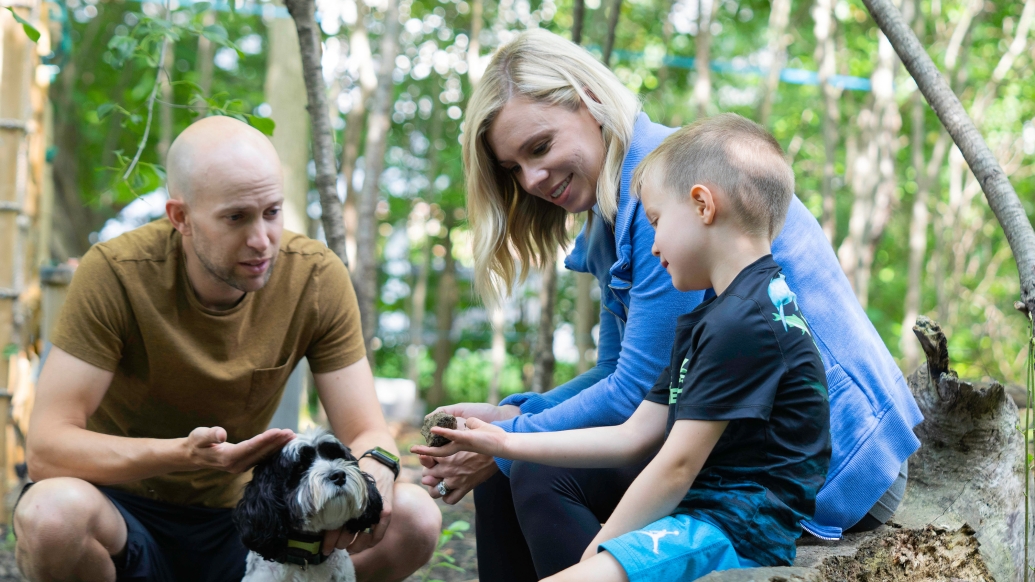A mom and melanoma survivor shares her best advice to set kids on a path toward preventing skin cancer
11:45 AM
Author |

Leah Koskinen comes by her melanoma prevention activism honestly.
She was just 25, and a new mom, when she was diagnosed with stage three melanoma in 2018.
Surgery and treatment at University of Michigan Health Rogel Cancer Center has helped her stay cancer-free in the six years since her diagnosis, but Koskinen is not one to simply accept her good fortune and call it a day.
“It’s always just kind of been in my nature to want to help other people,” Koskinen said.
“I really want to be there for someone else, and I’m a proactive person, so something I’m trying to do now with melanoma is prevention.”
With that in mind, Koskinen launched @makedermsure, an Instagram page containing facts and tips about preventing all types of skin cancer.
But her prevention efforts go beyond merely advocating that young moms and their kids (and everybody else) use more sunscreen.
Consider children’s playgrounds, Koskinen says.
They tend to be wide-open, sun-drenched spaces – Koskinen argues that school districts and municipalities should consider building shaded areas over at least part of the play area.
Heading outdoors with the kids on a warm summer day?
Besides smoothing on some sunscreen, wear sun-shading hats – and try some of the newer types of UV-blocking clothing, including loose-fitting, ultra-lightweight jackets that don’t have the heavy feel of UV-protective sun shirts (which some people find uncomfortable in the heat).
Maybe the most important tip for moms with kids is to start getting them used to wearing sunscreen when they’re little, she said.
“As soon as they can wear it, put it on,” Koskinen said.
“That, and being consistent – putting it on every time you go outside – are two good things.”
A couple of simple tricks can make it easier to apply sunscreen to a busy and active little person, Koskinen said.
And she should know – last summer she and her husband welcomed a second child to their growing family.
“I take a brush, like a makeup brush or sponge, and I put the sunscreen on that. Broad-spectrum sunscreen is best to protect against UV-A and UV-B. Then, from the brush, I put it on them, especially on their faces,” she said.
She hopes that as they grow, they’ll make sunscreen a part of their daily ritual, just like she does.
“I put it on first thing in the morning, rain or shine,” Koskinen said.
“We have bottles right by whatever doors we go out to play. If it becomes habitual, a routine, then it’s no big deal.”
Michigan Medicine pediatric dermatologist Jennifer Mancuso, M.D., agrees on the importance of sun protection for kids.
“The biggest purpose of sun protection early in life is protection from skin cancer later in life,” Mancuso said.
For that, sunscreen is an important factor – but certainly not the only one.
“Generally, sun protective clothing – long-sleeved swim shirts, hats, etc. – are much more effective at sun protection than sunscreen” – if you can convince children to wear them, Mancuso said.
“Clothing is definitely best. You don’t have to reapply it, and it doesn’t irritate the skin.”
When Mancuso talks to older kids in their teens or tweens she’ll often suggest wearing sun protective clothing when they’re with their families, and using sunscreen, reapplied generously every two hours, when they’re hanging out more socially with their friends.
“There’s a lot of UPF clothing that has been tested to ensure it has a specific level of sun protection,” she said, referring to garments’ Ultraviolet Protection Factor.
The higher the UPF number, the more protective the clothing is against the UV rays that cause sun damage.
Another key consideration, Mancuso says, is that sunscreen SPF ratings are based on using a really large quantity of sunscreen.
“People don’t usually use the thick layer of sunscreen required to meet standards,” she said.
Here are a few more sun safety tips:
- If you are outside more than 15 minutes between 10 a.m. and 4 p.m., apply sunscreen to all exposed areas and reapply at least every two hours
- Research sunscreens that work best for you, including lotions, gels, sticks and sprays, with a minimum SPF of 30; use SPF 50 for those prone to sunburn
- Shade outdoor spaces with large umbrellas; plant more shade trees
- Ensure sunscreen is liberally applied
- Wear makeup or moisturizers made with sunscreen on exposed areas of skin every day, even in the winter
Sign up for Health Lab newsletters today. Get medical tips from top experts and learn about new scientific discoveries every week by subscribing to Health Lab’s two newsletters, Health & Wellness and Research & Innovation.
Sign up for the Health Lab Podcast: Add us on Spotify, Apple Podcasts or wherever you get you listen to your favorite shows.

Explore a variety of health care news & stories by visiting the Health Lab home page for more articles.

Department of Communication at Michigan Medicine
Want top health & research news weekly? Sign up for Health Lab’s newsletters today!





